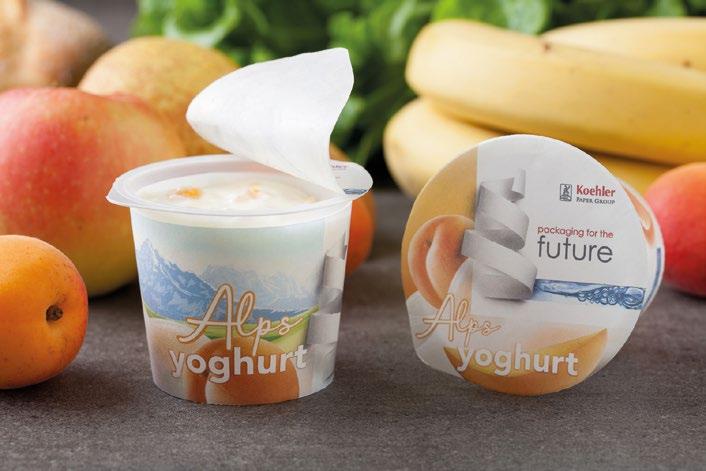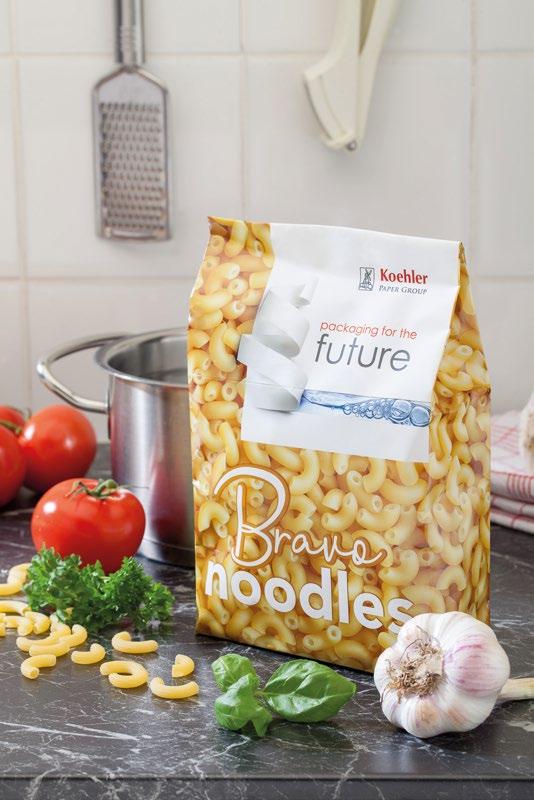
8 minute read
Challenging the ‘myths’ around paper packaging
CHALLENGING THE ‘MYTHS’ AROUND PAPER PACKAGING
For Koehler Paper Group – a long-established company but a relatively new entrant to the packaging market – there are many misconceptions around paper. Eckhard Kallies, Director of Flexible Packaging, and Jens Kriete, Sustainability Manager, explain why they believe brand owners should consider making the switch to this material.
Are we in the middle of a plastic backlash, or just at the start of it? Or are we seeing doubts emerging? We read stories about the LCA of paper and the resource-intense nature of its production; about the recycling rates and doubts about the use of timber. We know that achieving sufficient barrier properties for perishable goods is an ongoing challenge, as are increasingly stringent EU recycling quotas.
Without a doubt, these are all legitimate concerns, but what is the reality behind them? Koehler Paper Group is keen to at least address some of the ‘myths’ that have grown up around paper.
Claim: The paper industry is causing europe’s forests to shrink
Those who argue in favour of the use of forest products would say they that the forests are managed responsibly and they have been for centuries. As a side note: The German word for sustainability, ‘Nachhaltigkeit’, is actually a forestry term. According to Two Sides – between 2005 and 2020 European forests grew in area by 58,390 square kilometres. That’s an area bigger than Switzerland.
“This is actually not so easy to explain in two sentences. People have diffculties with the idea that trees are cut for paper and cut in general as we seem to have a certain emotional connection to trees,” says Jens Kriete. The rational side however is “Forests are a place of rising, growing and passing regardless of whether we intervene or not.”
“If forest is planted, about 2500 seedlings are planted per hectare. Nature can do it also on its own. If a forest area is cleared by a fire or storm soon young seedlings will reclaim that space and that can (depending on the local conditions) be many thousands per hectare. What will we see after 100 years? Well, we will see about 300 trees per hectare. Regardless of whether foresters thinned and harvested in the meantime or not Trees in forests compete for air, nutrients and water and not all trees survive that competition. Foresters make use of this process – they regularly harvest weaker trees helping the strong trees to get stronger quicker.”
Claim: Paper production is very resource- and C02- intensive
Europe’s paper industry is currently the biggest producer of renewable energy in the EU. Koehler’s own paper mill at Kehl uses biomass energy, and it is by no means the outlier: 60% of the industry’s fuel consumption is biomass-based, according to the FAO. If biofuel is predominantly employed, the argument goes, then the CO2 impact is greatly reduced.
According to CEPI, the direct CO2 emissions of the European pulp and paper industry reduced by 25% between 2005 and 2017.
It is true, however, that paper production is energy- and resource-intensive. When it comes to water; it is an integral part of the pulp and paper making process. That being said, the argument from the paper industry is that, while we use a lot of water, the industry’s water loops are optimized.

The vast percentage of the water is returned to the environment and methods for purifying wastewater are improving all the time.
What is required, says Eckhard Kallies, is for the industry to be entirely up-front about the energy and resources it uses and not shy away from diffcult questions such as those above. This involves a thorough life cycle analysis to back up any claims it makes about its solutions. “We need to have an honest approach with transparent analysis, e.g. LCA´s.
And after all, there is not one single metric by which sustainability can be measured
“We see an inflation of the words such as environmentally friendly and sustainable and they are usually made as absolute statements: ‘Environmentally friendly vehicle’ or ‘sustainable transport’, for example. People understand very well that that is contradictory. This makes it challenging for us to speak about our more sustainable packaging solutions. We at Koehler really want is to make a difference. Improvements must be measurable. That is the way we develop our products.”
Claim: Paper offers insufficient barrier properties
One of the main issues brand owners have had with paper, particularly when it comes to packaging perishable goods, comes down to resource effciency. Whereas many argue plastic films offer superior barrier properties, they say paper has yet to achieve the levels suffcient for product protection. And when paper is used to package food, it’s often combined with a polymer layer which can impact recyclability.



But this does not always have to be the case; the paper industry is working all the time on developing ever-more superior barrier papers. Koehler has been working with the University of Darmstadt since 2018 on a Green Coating Collaboration, geared towards developing functional surfaces from sustainable raw materials. It hopes, through this, to replace plastic with more sustainable paper solutions wherever this is practical or desirable.
Koehler’s recent advances in addressing this barrier challenge include NexPlus® Seal, a heat- sealable paper with a mineral oil barrier and a grammage of 45gsm to 80gsm. This was developed especially for use in food packaging, either as secondary packaging, or primary packaging, where no additional barriers are required. The solution offers mechanical product protection, thanks to its special surface, and also has a barrier against MOSH / MOAH (mineral oil vapour deposits from printing inks). Koehler NexPlus® Advanced is a barrier paper whose functional layer provides protection against oxygen and mineral oil and is also resistant to grease. As it can be processed with a cold seal adhesive, it is intended mainly for primary and secondary packaging for temperature-sensitive foods, such as chocolate bars, food bars and confectionery. It can also be used in the non-food sector, where such barriers are necessary.
Some also talk about the perceived ‘wastefulness’ of paper, something Jens Kriete is also keen to point out is what needs to be seen is. “Flexible packaging made of our NexFlex® material is recyclable wastepaper, goes into the wastepaper bin and even as waste it has a value. The value of wastepaper usually covers the costs of collection and sorting.”
Claim: Paper is too difficult to process on existing machinery
Of course, it’s not just about barriers or forestry: the production infrastructure needs to be able to support barrier papers. Many assume that such papers cannot run effciently on existing converting and packing machines, necessitating huge investments – something which may, in itself, be offputting for brand owners.
“Further processing was indeed seen as a problem in the past,” says Eckhard. “The perception was paper behaves differently to foil, is not as flexible and tears faster. On the contrary, we are working closely with packaging machine manufacturers and have achieved excellent results. Only very minor adjustments were needed on the packaging lines. Our paper runs as well as film on these machines. In addition, the paper can score points for printability.”
Where does the industry go from here?
None of this is to say that paper is the ‘perfect’ material. Indeed, a pragmatist would argue there is no such thing.
“Paper based packaging can be the most sustainable option for a whole world of applications,” says Jens Kriete. “However, we would not claim that that is always the case. Recently you might even have come across statements such as ‘The best packaging is no packaging’.” The value of packaging - protection, a longer shelf life, etc. - he argues, always needs to be higher than its costs and that also includes environmental costs, but also the costs of no-packaging such as damage and/or spoilage.
And of course, it’s one thing to explain why Koehler believes these myths around paper are wrong, and why it still feels paper is the most sustainable choice: naturally it believes this, or we wouldn’t be having the discussion.
But it’s not enough to simply counter these things. Innovators within the industry should make their voices heard when it comes to providing real solutions moving forward. This can often mean being courageous enough to make changes.
It’s important to point out that EU recycling targets are becoming – rightly – increasingly ambitious. By 2030, the EU Packaging and Packaging Waste Directive will be focused on real recycling as opposed to collection for recycling. This applies to all materials, and it’s certainly true that all could be doing more to improve their actual recycling rates.
What companies like Koehler and many others are crying out for is a unified approach to the problems facing the paper industry. “I guess, the biggest challenge for the industry is to break new ground and rethink packaging and their business model,” says Eckhard Kallies. “It is time to make fundamental changes throughout the whole supply chain. As a new entrant we face this every day and see perfect opportunities to make this happen with strategic development partners.” n













